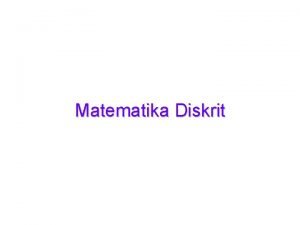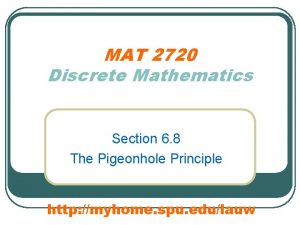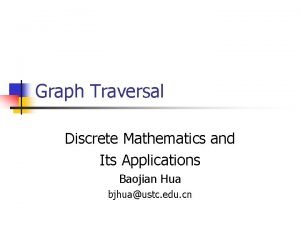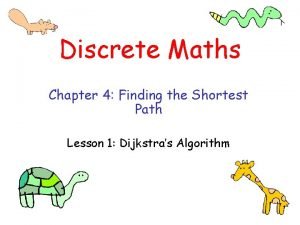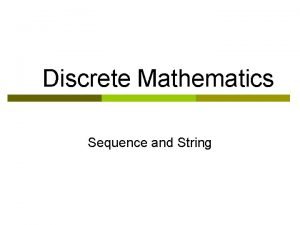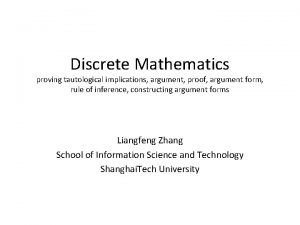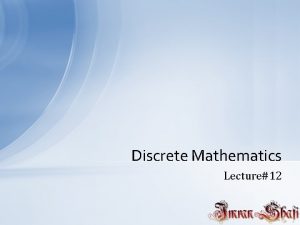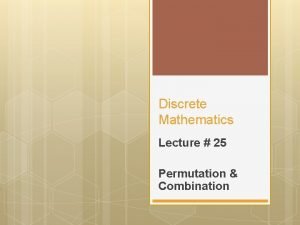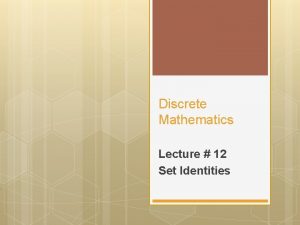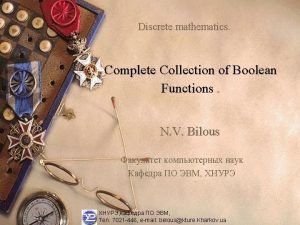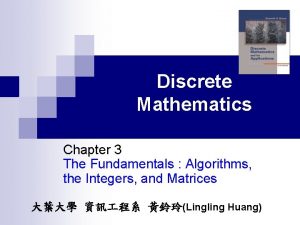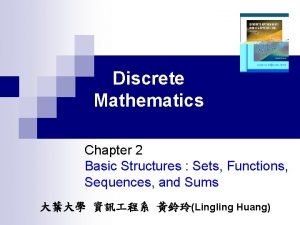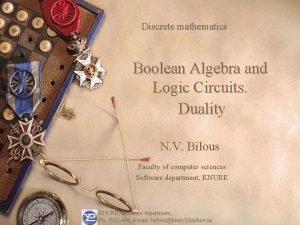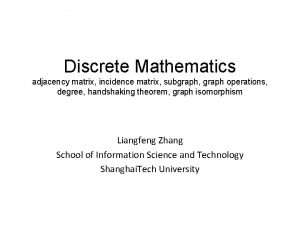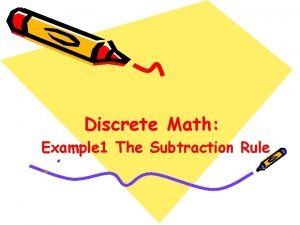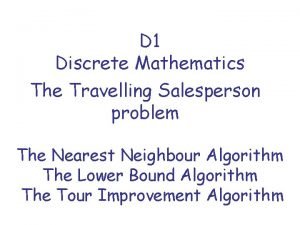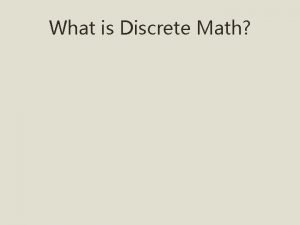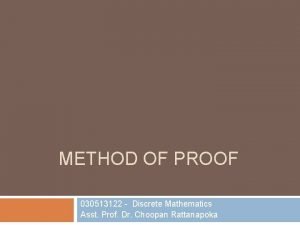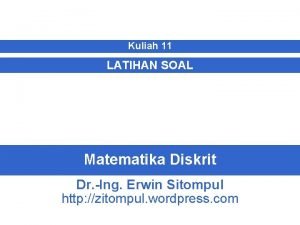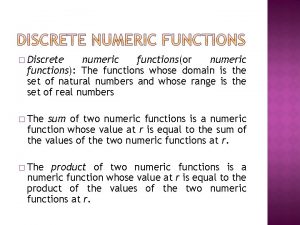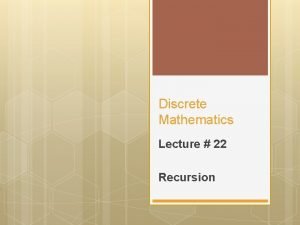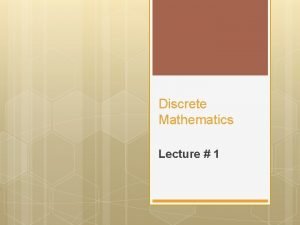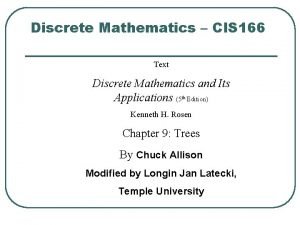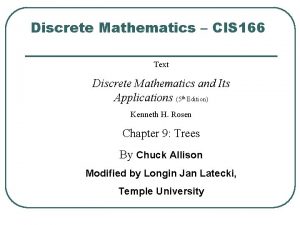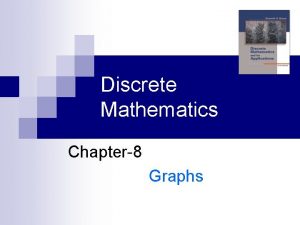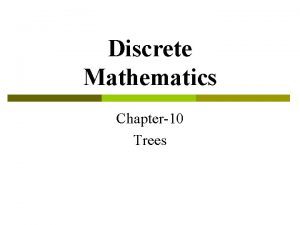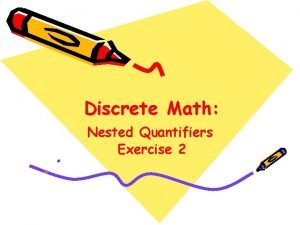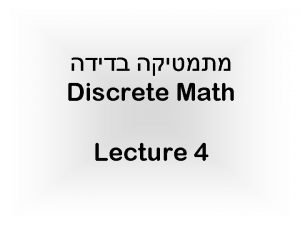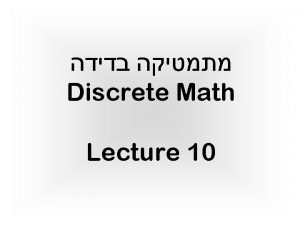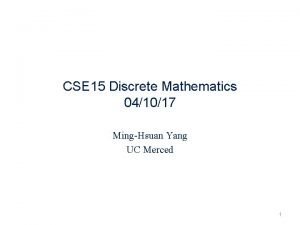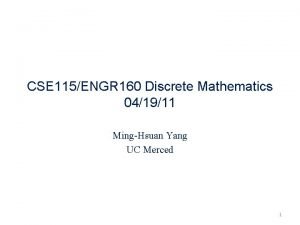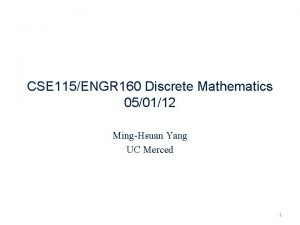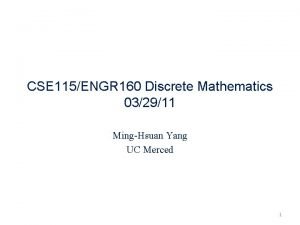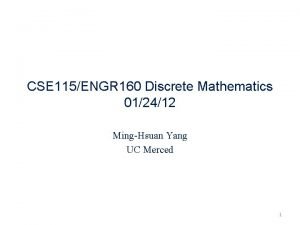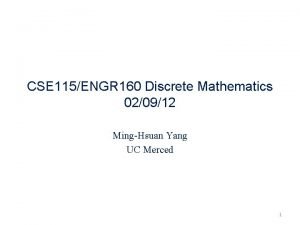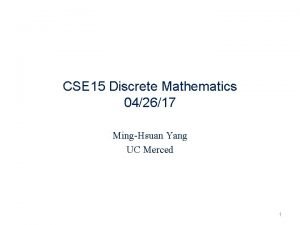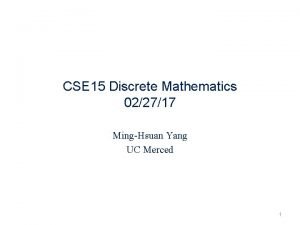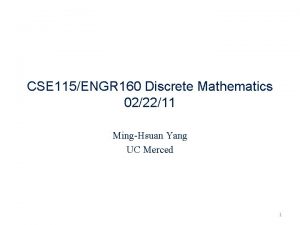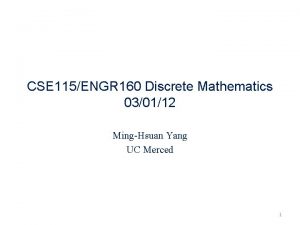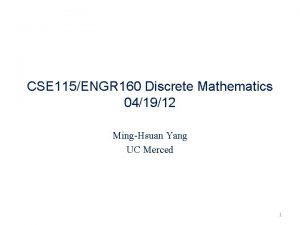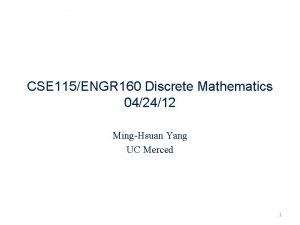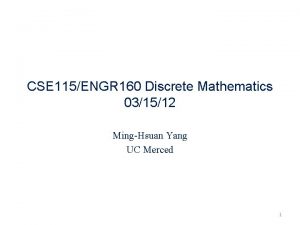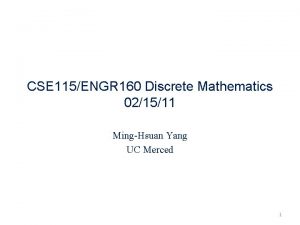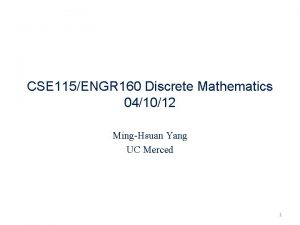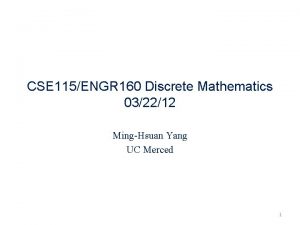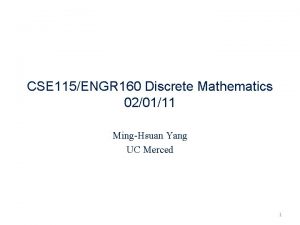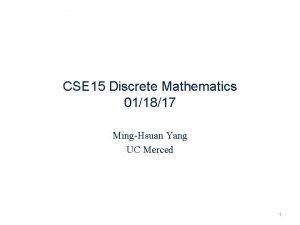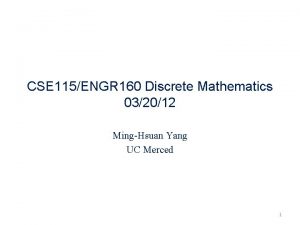CSE 15 Discrete Mathematics 021517 MingHsuan Yang UC

































- Slides: 33

CSE 15 Discrete Mathematics 02/15/17 Ming-Hsuan Yang UC Merced 1

2. 2 Set operations • Union: the set that contains those elements that are either in A or in B, or in both • A={1, 3, 5}, B={1, 2, 3}, A⋃B={1, 2, 3, 5} 2

Intersection • Intersection: the set containing the elements in both A and B • A={1, 3, 5}, B={1, 2, 3}, A⋂B={1, 3} 3

Disjoint set • Two sets are disjoint if their intersection is ∅ • A={1, 3}, B={2, 4}, A and B are disjoint • Cardinality: 4

Difference and complement • A-B: the set containing those elements in A but not in B • A={1, 3, 5}, B={1, 2, 3}, A-B={5} 5

Complement • Once the universal set U is specified, the complement of a set can be defined • Complement of A: • A-B is also called the complement of B with respect to A 6

Example • A is the set of positive integers > 10 and the universal set is the set of all positive integers, then • A-B is also called the complement of B with respect to A 7

Set identities 8

Set identities • Identity laws • Domination laws • Idempotent laws • Complementation law Continued on next slide

Set identities • Commutative laws • Associative laws • Distributive laws Continued on next slide

Set identities • De Morgan’s laws • Absorption laws • Complement laws

Example • Prove • Will show that • (→): Suppose that , by definition of complement and use De Morgan’s law • By definition of complement • By definition of union 12

Example • • • (←): Suppose that By definition of union By definition of complement Thus By De Morgan’s law: • By definition of complement, 13

Builder notation • Prove it with builder notation 14

Example • Prove • (→): Suppose that then and. By definition of union, it follows that , and or. Consequently, and or and • By definition of intersection, it follows or • By definition of union, 15

Example • (←): Suppose that • By definition of union, or • By definition of intersection, and or and • From this, we see , and or • By definition of union, and • By definition of intersection, , 16

Membership table Use a membership table to show A∩(B∪C)=(A∩B)∪(A∩C) 17

Example • Show that 18

Generalized union and intersection • A={0, 2, 4, 6, 8}, B={0, 1, 2, 3, 4}, C={0, 3, 6, 9} • A⋃B⋃C={0, 1, 2, 3, 4, 6, 8, 9} • A⋂B⋂C={0} 19

General case • • • Union: Intersection: Suppose Ai={1, 2, 3, …, i} for i=1, 2, 3, … 20

Computer representation of sets • U={1, 2, 3, 4, 5, 6, 7, 8, 9, 10} • A={1, 3, 5, 7, 9} (odd integer ≤ 10), B={1, 2, 3, 4, 5} (integer ≤ 5) • Represent A and B as 101010, and 1111100000 • Complement of A: 010101 • A⋂B: 101010˄1111100000=1010100000 which corresponds to {1, 3, 5} 21

2. 3 Functions • Assign each element of a set to a particular element of a second set 22

Function • A function f from A to B, f: A→B, is an assignment of exactly one element of B to each element of A • f(a)=b if b is the unique element of B assigned by the function f to the element a • Sometimes also called mapping or transformation 23

Function and relation • f: A→B can be defined in terms of a relation from A to B • Recall a relation from A to B is just a subset of A x B • A relation from A to B that contains one, and only one, ordered pair (a, b) for every element a ∈ A, defines a function f from A to B • f(a)=b where (a, b) is the unique ordered pair in the relation 24

Domain and range • If f is a function from A to B – A is the domain of f – B is the codomain of f – f(a)=b, b is the image of a and a is preimage of b – Range of f: set of all images of element of A – f maps A to B 25

Function • Specify a function by – Domain – Codomain – Mapping of elements • Two functions are equal if they have – Same domain, codomain, mapping of elements 26

Example • G: function that assigns a grade to a student, e. g. , G(Adams)=A • Domain of G: {Adams, Chou, Goodfriend, Rodriguez, Stevens} • Codomain of G: {A, B, C, D, F} • Range of G is: {A, B, C, F} 27

Example • Let R be the relation consisting of (Abdul, 22), (Brenda, 24), (Carla, 21), (Desire, 22), (Eddie, 24) and (Felicia, 22) • f: f(Abdul)=22, f(Brenda)=24, f(Carla)=21, f(Desire)=22, f(Eddie)=24, and f(Felicia)=22 • Domain: {Abdul, Brenda, Carla, Desire, Eddie, Felicia} • Codomain: set of positive integers • Range: {21, 22, 24} 28

Example • f: assigns the last two bits of a bit string of length 2 or greater to that string, e. g. , f(11010)=10 • Domain: all bit strings of length 2 or greater • Codomain: {00, 01, 10, 11} • Range: {00, 01, 10, 11} 29

Example • f: Z → Z, assigns the square of an integer to its integer, f(x)=x 2 • Domain: the set of all integers • Codomain: set of all integers • Range: all integers that are perfect squares, i. e. , {0, 1, 4, 9, …} 30

Functions • Two real-valued functions with the same domain can be added and multiplied • Let f 1 and f 2 be functions from A to R, then f 1+f 2, and f 1 f 2 are also functions from A to R defined by – (f 1+f 2)(x)= f 1(x)+f 2(x) – (f 1 f 2)(x)= f 1(x) f 2(x) • Note that the functions f 1+f 2 and f 1 f 2 at x are defined in terms f 1 and f 2 at x 31

Example • f 1(x) =x 2 and f 2(x)= x-x 2 – (f 1+f 2)(x)= f 1(x) +f 2(x)= x 2 + x-x 2 =x – (f 1 f 2)(x)= f 1(x) f 2(x)= x 2 (x-x 2)=x 3 -x 4 32

Function and subset • When f is a function from A to B (f: A→B), the image of a subset of A can also be defined • Let S be a subset of A, the image of S under function f is the subset of B that consists of the images of the elements of S • Denote the image of S by f(S) • f(S) denotes a set, not the value of function f 33
 Matematika diskrit kenneth rosen pdf
Matematika diskrit kenneth rosen pdf Pigeonhole principle in discrete mathematics
Pigeonhole principle in discrete mathematics Absorption law
Absorption law Kesetaraan logis
Kesetaraan logis Bfs and dfs in discrete mathematics
Bfs and dfs in discrete mathematics Dijkstra algorithm discrete mathematics
Dijkstra algorithm discrete mathematics Discrete mathematics
Discrete mathematics What is tautology in math
What is tautology in math Inverse relation
Inverse relation Applications of propositional logic in discrete mathematics
Applications of propositional logic in discrete mathematics Permutation and combination in discrete mathematics
Permutation and combination in discrete mathematics Discrete math identities
Discrete math identities Boolean functions in discrete mathematics
Boolean functions in discrete mathematics Homogeneous recurrence relation
Homogeneous recurrence relation The value of 52003 mod 7 is?
The value of 52003 mod 7 is? Onto function definition
Onto function definition Site:slidetodoc.com
Site:slidetodoc.com Law of duality in discrete mathematics
Law of duality in discrete mathematics Incidence matrix in discrete mathematics
Incidence matrix in discrete mathematics Subtraction rule in discrete mathematics
Subtraction rule in discrete mathematics Travelling salesman problem in discrete mathematics
Travelling salesman problem in discrete mathematics Discrete mathematics
Discrete mathematics Pqqpq
Pqqpq Discrete math questions
Discrete math questions Discrete numeric function example
Discrete numeric function example Recursion in discrete mathematics
Recursion in discrete mathematics Compound statement symbols
Compound statement symbols M ary tree in discrete mathematics
M ary tree in discrete mathematics M ary tree in discrete mathematics
M ary tree in discrete mathematics Connected simple graph
Connected simple graph What is rooted tree in discrete mathematics
What is rooted tree in discrete mathematics Nested quantifiers exercises
Nested quantifiers exercises Total function definition
Total function definition Partial order relation
Partial order relation
